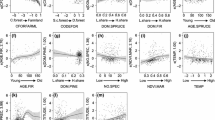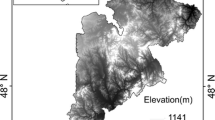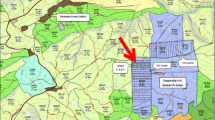Abstract
In natural boreal forests, disturbances such as fire and variation in surficial deposits create a mosaic of forest stands with different species composition and age. At the landscape level, this variety of stands can be considered as the natural mosaic diversity. In this paper, we describe a model that can be used to estimate the natural diversity level of landscapes. We sampled 624 stands for tree species composition and surficial deposits in eight stand-age classes corresponding to eight fire episodes in the region of Lake Duparquet, Abitibi, Québec at the southern fringe of the Boreal Forest. For six surficial deposit types, stand composition data were used to define equations for vegetation changes with time for a chronosequence of 230 years for four forest types. Using Van Wagner's (1978) model of age class distribution of stands, the proportion of each forest type for several lengths of fire cycle were defined. Finally, for real landscapes (ecological districts) of the ecological region of the “Basses-Terres d'Amos”, the proportion of forest types were weighted by the proportion of each surficial deposit type using ecological map information. Examples of the possible uses of the model for management purposes, such as biodiversity conservation and comparisons of different landscapes in terms of diversity and sensitivity to fire regime changes, are discussed.
Similar content being viewed by others
References
AttiwillP.M.: 1994a, ‘The disturbance of forest ecosystems: the ecological basis for conservative management’, For. Ecol. Manage. 63, 247–300.
AttiwillP.M.: 1994b, ‘Ecological disturbance and the conservative management of eucalypt forests in Australia’, For. Ecol. Manage. 63, 301–346.
BakerW.L.: 1989, ‘Landscape ecology and nature reserve design in the Boundary Waters Canoe Area, Minnesota’, Ecology 70, 23–35.
Béland, M.: 1990, ‘Le cadre écologique forestier du Québec: réalisation et applications dans un secteur de l'Abitibi’, M.Sc. Dissertation, Université du Québec à Montréal, Québec.
BergeronY.: 1991, ‘The influence of island and mainland lakeshore landscapes on boreal forest fire regimes’, Ecology 72, 1980–1992.
BergeronY., BouchardA., GangloffP. and CamiréC.: 1983, ‘La classification écologique des milieux forestiers de la partie ouest des cantons d'Hébécourt et de Roquemaure, Abitibi, Québec’, Etudes écologiques 9, Laboratoire d'écologie forestière, Université Laval, Québec.
BergeronY. and BouchardA.: 1984, ‘Use of ecological groups in analysis and classification of plant communities in a section of western Québec’, Vegetatio 56, 45–63.
BergeronY. and DansereauR.-P.: 1993, ‘Predicting the composition of Canadian southern boreal forest in different fire cycles’, J. Veg. Sci. 4, 827–832.
BonanG.B. and ShugartH.H.: 1989, ‘Environmental factors and ecological processes in boreal forests’, Annu. Rev. Ecol. Syst. 20, 1–28.
Canadian Forest Service: 1993, The State of Canada's Forests 1993, Natural Resources Canada, Ottawa, Ontario.
CarletonT.J. and MaycockP.F.: 1978, ‘Dynamics of the boreal forest south of James Bay’, Can. J. Bot. 56, 1157–1173.
ClarkJ.S.: 1988, ‘Effects of climate change on fire regime in northwestern Minnesota’, Nature 334, 233–235.
CogbillC.V.: 1985, ‘Dynamics of the boreal forests of the Laurentian Highlands, Canada’, Can. J. For. Res. 15, 252–261.
DansereauR.-P. and BergeronY.: 1993, ‘Fire history in the southern boreal forest of northwestern Quebec’, Can. J. For. Res. 23, 25–32.
EngelmarkO., KullmanL. and BergeronY.: 1994, ‘Fire and age structure of scots pine and norway spruce in northern sweden during the past 700 years’, New Phytol. 126, 163–168.
FormanR.T.T. and GodronM.: 1986, Landscape Ecology, Wiley & Sons, New York, USA.
FranklinJ.F.: 1993, ‘Preserving biodiversity: species, ecosystems, or landscapes’, Ecol. Appl. 3, 202–205.
FryerG.I. and JohnsonE.A.: 1988, ‘Reconstructing fire behavior and effects in a subalpine forest’, J. Appl. Ecol. 25, 1063–1072.
FultonM.R.: 1993, ‘Rapid simulation of vegetation stand dynamics with mixed life-forms’, In: A.M.Solomon and H.H.Shugart (eds.), Vegetation Dynamics and Global Change, Chapman & Hall, New York, pp. 251–271.
Gauthier, S.: 1991, ‘Structure génétique et sérotinisme de populations de pin gris (Pinus banksiana Lamb.) soumises à deux régimes des feux distincts’, Ph.D. Thesis, Université de Montréal, Québec.
HansenA.J., SpiesT.A., SwansonF.J. and OhmannJ.L.: 1991, ‘Conserving biodiversity in managed forests: lessons from natural forests’, BioScience 41, 382–392.
HeinselmanM.L.: 1981, ‘Fire and succession in the conifer forests of northern North America’, In: D.H.West, H.H.Shugart and D.B.Botkin (eds.), Forest Succession: Concept and Applications, Springer-Verlag, New York, pp. 375–405.
JohnsonE.A.: 1992, Fire and Vegetation Dynamics: Studies from the North American Boreal Forests, Cambridge Studies in Ecology, Cambridge University Press, New York, 129 pp.
MladenoffD.J., WhiteM.A., PastorJ. and CrowT.R.: 1993, ‘Comparing spatial pattern in unaltered old-growth and disturbed forest landscapes’, Ecol. Appl. 3, 294–306.
NossR.F.: 1983, ‘A regional landscape approach to maintain diversity’, BioScience 33, 700–706.
NossR.F.: 1987, ‘Protecting natural areas in fragmented landscapes’, Natural Areas Journal 7, 2–13.
PickettS.T.A. and WhiteP.S.: 1985, The Ecology of Natural Disturbance and Patch Dynamics, Academic Press, New York.
PimentelD., StachowU., TakacsD.A., BrubakerH.W., DumasA.R., MeaneyJ.J., O NeilJ.A.S., OnsiD.E. and CorziliusD.B.: 1991, ‘Conserving biological diversity in agricultural/forestry systems’, BioScience 42, 354–362.
PrenticeI.C. and LeemansR.: 1990, ‘Pattern and process and the dynamics of forest structure: a simulation approach’, J. Ecol. 78, 340–355.
RebertusA.J., BurnsB.R. and VeblenT.T.: 1991, ‘Stand dynamics of Pinus flexilis-dominated subalpine forests in the Colorado Front Range’, J. Veg. Sci. 2, 445–458.
RobitailleA.: 1989, ‘Cartographie des districts écologiques: normes et techniques’, Ministère de l'Energie et des Ressources, Service de l'inventaire forestier, Division écologique, Québec.
RommeW.H.: 1982, ‘Fire and landscape diversity in subalpine forests of Yellowstone National Park’, Ecol. Monogr. 52, 199–221.
RoweJ.S.: 1972, Forest Regions of Canada, Environ. Can., Ottawa, Ontario.
ShannonC.E.: 1948, ‘A mathematical theory of communication’, Bell System Tech. J. 27, 379–423.
ShugartH.H.: 1984, A Theory of Forest Dynamics, The Ecological Implications of Forest Succession Models, Springer-Verlag, New York.
SimsR.A., TowillW.D., BaldwinK.A. and WickwareG.M.: 1989, Field Guide to Forest Ecosystems Classification for Northwestern Ontario, Ont. Min. Nat. Res., Toronto, Ontario.
StocksB.J.: 1985, ‘Forest fire behavior in spruce budworm-killed balsam fir’, In: Recent Advances in Spruce Budworm Research Proc. CANUSA Spruce Budworm Res. Symp., Sept. 16–20, 1984, Bangor, ME., Govt. Can., Can. For. Serv., Ottawa, Ontario, pp. 188–199.
StocksB.J. and SimardA.J.: 1993, ‘Forest fire management in Canada’, J. Disaster Manage. 5, 21–27.
TurnerM.G. and RommeW.H.: 1994, ‘Landscape dynamics in crown fire ecosystems’, Landscape Ecol. 9, 59–77.
TurnerM.G., RommeW.H., GardnerR.H., O NeillR. and KratzT.K.: 1993, ‘A revised concept of landscape equilibrium: disturbance and stability on scaled landscapes’, Landscape Ecol. 8, 213–227.
VanWagnerC.E.: 1978, ‘Age-class distribution and the forest fire cycle’, Can. J. For. Res. 8, 220–227.
ViereckL.A.: 1983, ‘The effects of fire in black spruce ecosystems of Alaska and northern Canada’, In: R.W.Wein and D.A.MacLean (eds.), The Role of Fire in Northern Circumpolar Ecosystems, John Wiley & Sons, New York, pp. 201–220.
VincentJ.S. and HardyL.: 1977, ‘L'évolution et l'extinction des lacs glaciaire Barlow and Ojibway en territoire québécois’, Géogr. Phys. Quat. 31, 357–372.
Author information
Authors and Affiliations
Rights and permissions
About this article
Cite this article
Gauthier, S., Leduc, A. & Bergeron, Y. Forest dynamics modelling under natural fire cycles: A tool to define natural mosaic diversity for forest management. Environ Monit Assess 39, 417–434 (1996). https://doi.org/10.1007/BF00396159
Issue Date:
DOI: https://doi.org/10.1007/BF00396159




